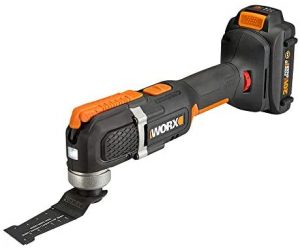Table of Contents
Introduction
An oscillating tool is a lesser-known power tool when compared to tools like drills and circular saws. However, this doesn’t mean the device is limited in function. It can be used when you have a wood piece that you need to be smoothed or apply wood fillers. An oscillating tool, also referred to as a multi-tool, is a power tool oscillates rather than rotating or reciprocating; and this draws a curious picture in our head. How does an oscillating tool work?
How does it Work?
The oscillating tool works by oscillating the head at high speeds up to 20,000 times in a minute. Either battery power it, or you connect it to a power supply. The multi-tool looks similar to a grinder with a device that allows you to fix attachments.
Common Uses of Oscillating Tools
The multi-tool is very versatile, and its uses are as numerous as the number of attachments you can get for it. When you are equipped with the right blades, you can make flush cuts and trimming wood. If you have a pipe, you need to cut, but it is hard to reach, get an oscillating multi-tool.
Plunge cuts into the wood are easy and smooth without marring other parts of the surface. Grout removal and sanding surfaces are among the typical applications of the oscillating tool. What makes the multi-tool such a great power tool is that it can reach places you will otherwise not get; it offers you flexibility. If you need to cut a precise recess without removing the object, you will need an oscillating tool.
Oscillating Tools Accessories
There is an attachment for almost any use you’ll have while using the oscillating tool. Do you have metal, wood, or PVC you need to cut? Then get the right attachment. You can get sanders, grinders, polishing pads, scrapers accessories depending on your need.
Below are the most common blades you should have:
- Scraper blades, which are great to apply putty
- Rounded blades for long cuts
- Bimetal blade if you need to cut through metal
- Diamond grit blades are sturdy enough to remove grout
Depending on the brand of your tool, there are different connections set up for the blades. However, some of the oscillating tools’ blades can work well with other brands. If the blades and accessories do not fit, it may be possible to get an adapter. An oscillating tool can only cut as deep as its blade’s length.
Before You Get an Oscillating Tool
Before getting an oscillating tool, here are some things you may need to consider.
Price
There are cheap and expensive multi-tools you can get, but the choice ultimately rests on you. Professionals may want to get more costly variants because of extensive features. A novice or a hobbyist should go for the less expensive types.
Power
Most multi-tools have an average of 18000 to 20000 oscillations per minute. Check the power rating on the oscillating tool to ensure it can serve your purpose.
Power Source
When you are about to get an oscillating tool, you need to decide whether it’s a battery-powered or corded one you want to get. If you need raw power, go for the corded type because the battery-powered ones can’t deliver as much power and have a limited time to use it.
Blade Attachment
There are different configurations for the head of the too. Check whether your tool can accommodate blades from other brands. You can still buy your oscillating tool even if it doesn’t support other blades as long as you can cope with buying just branded blades.
Oscillation Angle
The higher the oscillation angle, the more speed the oscillation tool has, but the downside is that it becomes noisier and causes more vibrations.
You can look out for more features you think will come in handy when shopping for a multi-tool.
Conclusion
An oscillating tool is called the multi too because of its versatile nature. Remember that this is a power tool, so that it may be too loud during operation. If you are the handyman in your home, this is an excellent opportunity for you to take advantage of everything the tool offers.

